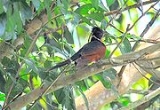
Chestnut-winged Cuckoo
Encyclopedia
The Chestnut-winged Cuckoo or Red-winged Crested Cuckoo (Clamator coromandus) is a cuckoo
found in Southeast Asia and parts of South Asia. It has dark glossy upperparts, a black head with long crest chestnut wings, a long graduated glossy black tail, rufous throat dusky underside and a narrow white nuchal half collar. They breed along the Himalayas
and migrate south in winter to Sri Lanka
, southern India and tropical Southeast Asia including parts of Indonesia, Thailand and the Philippines. It is about 47 cm long.
Coromande". The species was later placed under the genus names of Coccystes, Oxylophus before being placed in Clamator.
 The species is found from the western Himalayas to the eastern Himalayas and extends into Southeast Asia. It has been recorded from India, Nepal, China, Indonesia, Laos, Bhutan, Bangladesh, Cambodia, Thailand, Myanmar, Malaysia, Vietnam, Sri Lanka and the Philippines. Some populations may be non-migratory.
The species is found from the western Himalayas to the eastern Himalayas and extends into Southeast Asia. It has been recorded from India, Nepal, China, Indonesia, Laos, Bhutan, Bangladesh, Cambodia, Thailand, Myanmar, Malaysia, Vietnam, Sri Lanka and the Philippines. Some populations may be non-migratory.
During migration in India, it moves along the Eastern Ghats in its southward migration with exhausted individuals often being discovered in the vicinity of homes. In mid-October, they are found in numbers at Point Calimere, possibly in to Sri Lanka. Some appear to winter in the Western Ghats.
Cuckoo
The cuckoos are a family, Cuculidae, of near passerine birds. The order Cuculiformes, in addition to the cuckoos, also includes the turacos . Some zoologists and taxonomists have also included the unique Hoatzin in the Cuculiformes, but its taxonomy remains in dispute...
found in Southeast Asia and parts of South Asia. It has dark glossy upperparts, a black head with long crest chestnut wings, a long graduated glossy black tail, rufous throat dusky underside and a narrow white nuchal half collar. They breed along the Himalayas
Himalayas
The Himalaya Range or Himalaya Mountains Sanskrit: Devanagari: हिमालय, literally "abode of snow"), usually called the Himalayas or Himalaya for short, is a mountain range in Asia, separating the Indian subcontinent from the Tibetan Plateau...
and migrate south in winter to Sri Lanka
Sri Lanka
Sri Lanka, officially the Democratic Socialist Republic of Sri Lanka is a country off the southern coast of the Indian subcontinent. Known until 1972 as Ceylon , Sri Lanka is an island surrounded by the Indian Ocean, the Gulf of Mannar and the Palk Strait, and lies in the vicinity of India and the...
, southern India and tropical Southeast Asia including parts of Indonesia, Thailand and the Philippines. It is about 47 cm long.
Description
This dark and crested cuckoo has chestnut wings, a glossy black crest and a graduated tail (the feathers shortening in steps from the center outwards) whose terminal edges are white and inconspicuous unlike the white tips of the Jacobin Cuckoo which is found in parts of its range. The black capping on the head is broken from black of the back by a white collar that extends to the sides of the neck. The lower parts are rufous turning to dark grey towards the vent. Young birds are dusky with a scaly appearance to the wing feathers.Taxonomy
The species was first given its binomial name by Linnaeus in 1766. His description of what he called Cuculus coromandus was based on the notes of Brisson who described the bird as "Le coucou hupé de Coromandel" which was collected on the Coromandel coast of India (probably near Pondicherry which was a French colony). Buffon noticed the close relation to the Jacobin Cuckoo and called it "le Jacobin huppé deCoromande". The species was later placed under the genus names of Coccystes, Oxylophus before being placed in Clamator.
Distribution

During migration in India, it moves along the Eastern Ghats in its southward migration with exhausted individuals often being discovered in the vicinity of homes. In mid-October, they are found in numbers at Point Calimere, possibly in to Sri Lanka. Some appear to winter in the Western Ghats.

